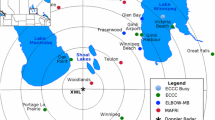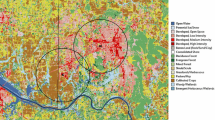Abstract
A study of an interesting meteorological episode over the Owens Valley, California, USA during the Terrain-Induced Rotor EXperiment was conducted using a recently adapted statistical interpolation method to retrieve wind-velocity vectors from Doppler lidar data. This vector retrieval method has been adapted from radar data assimilation techniques. Results show that the method allows better preservation of local variations in the flow field than other techniques. In addition, a high resolution Coupled Ocean/Atmosphere Mesoscale Prediction System (COAMPS®) run is used to understand the large-scale flow within the valley and compared with lidar retrievals. Observations from 1030 UTC to 1230 UTC (0230 local time to 0430 local time) on March 27, 2006 are presented. Lidar observations show complex and uncharacteristic flows such as sudden bursts of westerly cross-valley wind mixing with the dominant up-valley wind. Model results from COAMPS and other in-situ instrumentation are used to corroborate and complement these observations. The optimal interpolation technique for Doppler lidar data vector retrieval appears well suited for scenarios with complex spatial variations in the flow field.
Similar content being viewed by others
References
Banta RM, Darby LS, Kaufmann P, Levinson DH, Zhu CJ (1999) Wind-flow patterns in Grand Canyon as revealed by Doppler lidar. J Appl Meteorol 38: 1069–1083
Banta RM, Newsom RK, Lundquist JK, Pichugina YL, Coulter RL, Mahrt L (2002) Nocturnal low-level jet characteristics over Kansas during CASES-99. Boundary-Layer Meteorol 105: 221–252
Banta RM, Pichugina YL, Kelley ND, Jonkman B, Brewer WA (2008) Doppler lidar measurements of the Great Plains low-level jet: applications to wind energy. In: 14th international symposium for the advancement of boundary layer remote sensing
Browning K, Wexler AR (1968) The determination of kinematic properties of a wind field using Doppler radar. J Appl Meteorol 7: 105–113
Daley R (1991) Atmospheric data analysis. Cambridge University Press, Cambridge, 457 pp
Doyle JD, Durran DR (2002) The dynamics of mountain-wave induced rotors. J Atmos Sci 59: 186–201
Gal-Chen T, Xu M, Eberhard W (1992) Estimations of atmospheric boundary layer fluxes and other turbulence parameters from Doppler lidar data. J Geophys Res 97: 409–418
Grubišić V, Billings BJ (2007) The intense lee-wave rotor event of Sierra Rotors IOP8. J Atmos Sci 64: 4178–4201
Grubišić V et al (2008) The terrain-induced rotor experiment: an overview of the field campaign and some highlight of special observations. Bull Am Meteorol Soc 89: 1513–1533
Hill M, Calhoun R, Fernando HJS, Wieser A, Dornbrack A, Weissmann M, Mayr G, Newsom R (2010) Coplanar Doppler lidar retrievals of rotors from T-REX. J Atmos Sci 67: 713–729
Jiang Q, Doyle JD (2008) Diurnal variation of downslope winds in Owens Valley during the Sierra Rotor experiment. Mon Weather Rev 136: 3760–3780
Kahn BH, Chan W, Lester PF (1997) An investigation of rotor flow using DFDR data. In: Proceedings of the seventh conference on aviation, range, and aerospace meteorology, Long Beach, CA. American Meteorological Society, pp 206–210
Kongara S, Calhoun R, Choukulkar A, Boldi MO (2012) Velocity retrievals for coherent Doppler lidar. Int J Remote Sens 33(11): 3596–3613
Lin C, Xia Q, Calhoun R (2008) Retrieval of urban boundary layer structures from Doppler lidar data. Part II: proper orthogonal decomposition. J Atmos Sci 65: 21–42
Lorenc A (1981) A global three dimensional multivariate statistical analysis system. Mon Weather Rev 109: 701–721
Mellor GL, Yamada T (1982) Development of a turbulent closure model for geophysical fluid problems. Rev Geophys Space Phys 20(4): 851–875
Newsom R, Chai T, Lin C (2004) Retrieval of microscale flow structures from high resolution Doppler lidar data using an adjoint model. J Atmos Sci 61: 1500–1520
Porch WM, Clements WE, Coulter RL (1991) Nighttime valley waves. J Appl Meteorol 30: 145–156
Princevac M, Hunt JCR, Fernando HJS (2008) Quasi-steady katabatic winds on slopes in wide valleys: hydraulic theory and observations. J Atmos Sci 65: 627–643
Schmidli J, Poulos GS, Daniels MH, Chow FK (2009) External influences on nocturnal thermally driven flows in a deep valley. J Appl Meteorol Climatol 48: 3–23
Weissmann M, Dornbrack A, Doyle JD (2009) Vorticity from line-of-sight lidar velocity scans. J Atmos Ocean Technol 26: 2683–2690
Whiteman CD (1990) Observations of thermally developed wind systems in mountainous terrain. In: Blumen W (ed) Atmospheric processes over complex terrain. Meteorological monographs, 23, no. 45. American Meteorological Society, Boston, pp 5–42
Whiteman CD (2000) Mountain meteorology: fundamentals and applications. Oxford University Press, New York, 355 pp
Whiteman CD, Doran CJ (1993) The relationship between overlying synoptic scale flows and winds within a valley. J Appl Meteorol 32: 1669–1682
Whiteman CD, Hoch SW, Poulos GS (2009) Evening temperature rises on valley floors and slopes: their causes and their relationship to the thermally driven wind system. J Appl Meteorol Climatol 48: 776–788
Xia Q, Lin C, Calhoun R, Newsom R (2008) Retrieval of urban boundary layer structures from Doppler lidar data. Part I: accuracy assessment. J Atmos Sci 65: 3–20
Xu Q, Gong J (2003) Background error covariance functions for Doppler radial-wind analysis. Q J R Meteorol Soc 129: 1703–1720
Xu Q, Liu S, Xue M (2006) Background error covariance functions for velocity wind analysis using Doppler radar radial-velocity observations. Q J R Meteorol Soc 132: 2887–2904
Xu Q, Nai K, Wei L (2007) An innovation method for estimating radar radial-velocity observation error and background error covariances. Q J R Meteorol Soc 133: 407–415
Author information
Authors and Affiliations
Corresponding author
Rights and permissions
About this article
Cite this article
Choukulkar, A., Calhoun, R., Billings, B. et al. Investigation of a Complex Nocturnal Flow in Owens Valley, California Using Coherent Doppler Lidar. Boundary-Layer Meteorol 144, 359–378 (2012). https://doi.org/10.1007/s10546-012-9729-2
Received:
Accepted:
Published:
Issue Date:
DOI: https://doi.org/10.1007/s10546-012-9729-2




